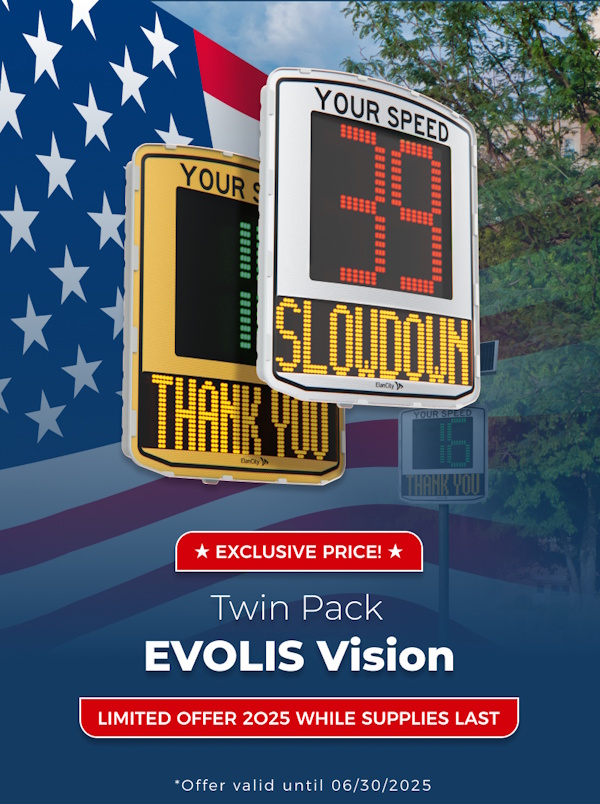5 questions to ask yourself before buying a Radar Speed Sign
Choosing the right option for your requirements
In order for your Radar Speed Sign to be effective, you need to choose the right options for the relevant factors of the location and communites requirements. By answering the following questions, you will have a better idea of the type of Speed Indicator Device you need.
1) What type of Radar Speed Sign do we need: stationary, portable or ultra-portable?
For the most cost-effective and practical solution, you must think carefully about how you intend to use the Speed Indicator Device (SID) so you can choose the right one for your community!
Stationary use: this Radar Speed Sign is permanently installed on a site that needs ongoing monitoring of traffic speed. For example, this is a good option to protect the area around a school or to make the entrance to the town safer.
Portable use: this Radar Speed Sign can be moved from time to time (e.g. quarterly to secure several areas of the municipality) or shared between several municipalities.
These two types of Speed Indicator Devices (SID) are available in solar and electric versions, as well as a double power supply. The solar-powered version can be placed on a dedicated mast with an above-ground concrete base to make it easier to move in the event of semi-stationary use.
It should be noted that only a qualified electrician should install the electrical version.
Ultra-portable use: this Radar Speed Sign is designed to be conveniently moved fortnightly. For example, you could move it to different locations for traffic data analysis.
This Speed Indicator Device is 100% battery-powered and moved more than once a month. You can easily install it on existing poles in your community.
2) What is the best location for my Speed Indicator Device?
The best location is any area in your community where speeding is a significant issue, either due to multiple car accidents or where locals are calling for speed limit reductions due to safety concerns.
They are generally most effective when installed at the entrances to built-up areas, where they remind drivers to reduce speed as they are entering a town, so the speed limit has dropped from 70, 80 or 90 km/h to 30 or 50 km/h. You can also install them near schools pedestrian crossings or before intersections to protect pedestrians, especially children.
You must also consider the safety and regulatory measures for installing your radar:
• it should be on the right-hand side of the road (in the direction of travel) and as far as possible perpendicular to the road axis
• the Radar Speed Sign shall be installed at least 2.30 metres above the ground (so it does not obstruct pedestrians)
These key figures will help establish optimal placement:
• the ideal placement is on a straight line of 200 metres, the distance from which the Radar Speed Sign can be seen by a motorist
• the Doppler antenna of the Speed Indicator Device detects approaching vehicles up to 300m away
• the displayed speed is updated every 1.2 seconds
3) How do I decide which power source to choose?
The different power source options are:
Solar connection: the Radar Speed Sign is equipped with two batteries and powered by a 100 Watt photovoltaic panel, guaranteeing complete autonomy all year round.
Electric: the Radar Speed Sign is powered either by a permanent current or by the public lighting network, with a minimum charging time of 5 hours at night. This option should not be used if you switch off the street lighting at night.
Dual feed: This option combines a solar panel and an electrical connection, providing a back-up source of power case the primary power supply is not sufficient. For example: if the solar power supply is not enough when the site is shaded, you can switch to electricity; alternately, the solar power can act as back-up if you are connected to public lighting but don’t have the required 5 hours of charging time.
Batteries: 2 extra batteries and an external charger for an autonomy between 7 and 10 days
According to our figures, 80% of local authorities that have installed a Speed Indicator Device have chosen solar power, as they find this to be the most practical option.
4) Will my municipality be able to afford the installation of the Radar Speed Sign?
Yes, in most cases there is no additional cost as you do not need a service provider.
You don’t need any technical expertise to install the Radar Speed Sign, and this is even more true if it is the solar version. Elan City’s teams will advise you on how to adapt the product to your existing installations, and they can include all the necessary additions to your order (extra mounting equipment etc.)
5) How does statistical reporting work?
The data is collected from the Speed Indicator Device via a USB, Bluetooth or 3G/4G connection, so it can be transferred to a computer for analysis.
The Radar Speed Sign can record the average and maximum speeds or the number of vehicles in both directions of traffic, in order to evaluate the behaviour of users who are facing the sign and those who are not.
Keep your community safe!
Choose Elan City – contact us today to request a quote, so we can help you find the right solutions for your community.






